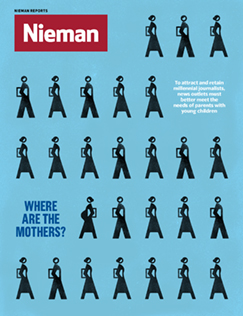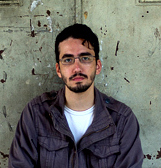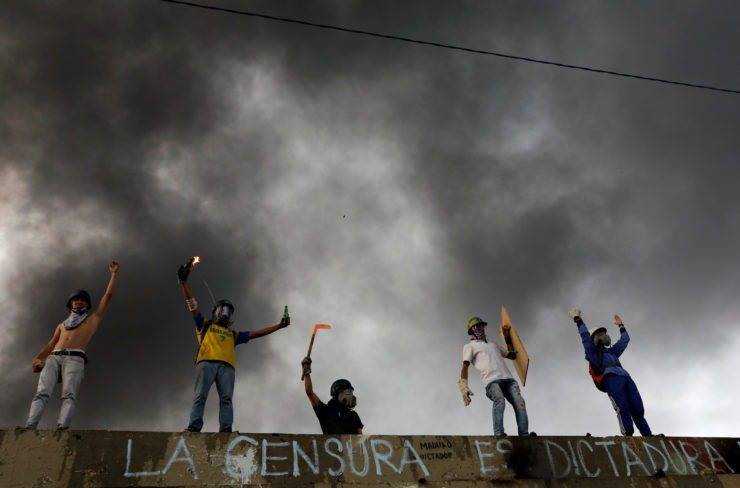
Demonstrators gesture to riot security forces while rallying against President Nicolás Maduro over graffiti that reads "censorship is dictatorship" in Caracas, Venezuela, May 2017
Venezuelan pop singer Miguel Ignacio Mendoza was part of a crowd of thousands of people on the streets of Caracas on April 10. He wasn’t giving a concert, but taking part in demonstrations against the Supreme Court’s decision to dissolve the National Assembly, a decision the Court later reversed after three days of nationwide protests.
The largely peaceful protestors—including Mendoza, more popularly known as Nacho—were met with tear gas fired by police clad in riot gear on the streets and in helicopters. At a protest that same day in Valencia, 100 miles west of Caracas, a 20-year-old student was killed, shot in the neck by police.
Efecto Cocuyo was at the Caracas protest, too, broadcasting the clashes live over Periscope. The independent digital political news outlet has been using Periscope since the app’s launch in 2015 as an alternative to Venezuela’s legacy TV news organizations, which focus solely on pro-government content and studiously avoid showing any of the unrest that’s been roiling the country for the past three years. In February the site launched a weekly news program broadcast exclusively on Periscope. “Con la Luz” (“With the Light”) airs every Friday afternoon with in-depth interviews and debates on current social and political issues.
Efecto Cocuyo’s audience is still comparatively small—a typical Periscope piece reaches an audience of around 3,000; the April 10 broadcast was the site’s biggest ever, drawing over 60,000 viewers—but its effort is typical of the sense of energy and urgency among Venezuela’s digital news upstarts to provide accurate, independent coverage of the turmoil engulfing the country. “One of the biggest lessons and benefits we’re experiencing is that the most serious, responsible, and rigorous journalism is being recognized by audiences,” says Omar Lugo, a content director at El Estímulo, another new digital news outlet, “because people want to be truly informed instead of reading rumors on social media.”
During the latest round of unrest, clashes have left more than 60 people dead and hundreds arrested and injured, including several journalists. Hundreds of thousands of Venezuelans have taken to the streets daily (at the height of the protests, the “Mother of All Marches” on April 19, that number rose to an estimated 2.5 million demonstrators in Caracas alone) to protest the policies of President Nicolás Maduro—who has become increasingly unpopular since being elected in 2013 following the death of Hugo Chávez—demanding Maduro’s removal from office, immediate elections, and the release of opposition leaders from prison. The political turmoil is further fueled by severe shortages of food, medicine, and basic goods that have resulted from the oil-rich country’s economic collapse. At the end of 2016, the inflation rate hit 720 percent; it is expected to rise to over 2000 percent by 2018, according to projections by the International Monetary Fund, though some believe these estimates are way off.
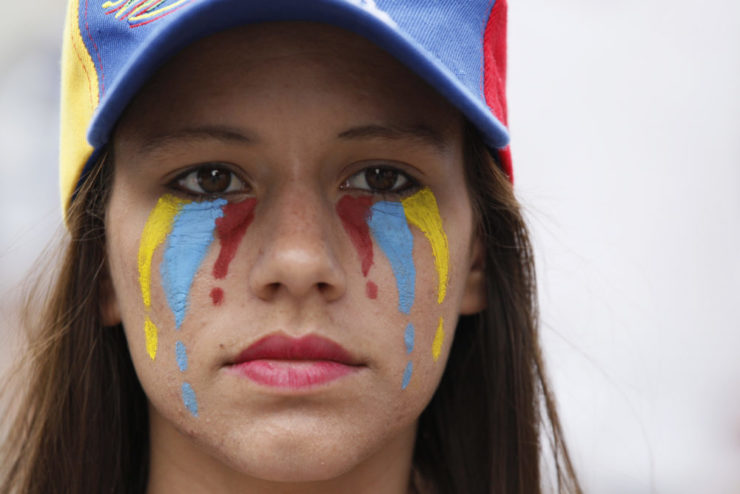
More than 60 people have been killed in the latest wave of protests in Venezuela this spring, with hundreds of others—including journalists—injured. Here, a woman with her face painted in the colors of Venezuela's national flag attends a silent protest in homage to those killed
In the 18 years since Hugo Chávez came to power, winning an election six years after he led an unsuccessful military coup to overthrow centrist president Carlos Andrés Pérez in 1992, five television channels have been closed and nine removed from cable television subscription services; 62 radio stations have gone off the air because of official prohibitions; and the government has fined media outlets 32 times. “Legislation has limited freedom of expression and access to public sources,” says Marcelino Bisbal, director of Postgraduate Communication Studies at the Universidad Católica Andrés Bello. “It has significantly reduced the number of informative sources available and has generated actual censorship and self-censorship.”
Though it has escalated in recent months, Venezuela’s current crisis began in February of 2014, when local protests about the sexual assault of a student at the University of Los Andes, in the state of Táchira, expanded to cities across Venezuela. The issues protesters wanted addressed expanded, too: improved public security, solutions for economic instability and high inflation, and an end to government infringements on civil rights. In the streets of Caracas, Venezuela’s capital, protests have become increasingly violent, with government forces threatening the opposition with not just tear gas, rubber bullets, and water cannons but firearms. Protesters, too, have at times resorted to extreme violence; at a demonstration in May, a large group surrounded a man, doused him in gasoline, and set him on fire. Maduro accused the crowd of targeting the man because he was pro-government, though witnesses say the group accused the victim of being a thief.
The early days of The Exit movement provided digital outlets with new opportunities and new audiences
During the protests of 2014, images of what was happening were barely seen on mainstream media. The head of the National Telecommunication Commission announced that “coverage of the violent events” was punishable under the Radio, TV and Electronic Media Social Responsibility Law, which bans content condoning violence or hatred. The international television station NTN24, which had been broadcasting live coverage of the protests, was removed from the Venezuelan cable providers DirecTV and Movistar TV by government order, and access to it remains restricted today. President Nicolás Maduro announced that his government would “adopt measures” against Agence France-Presse for having “distorted the truth” about the protests. The Ministry of Communication and Information also threatened to sue international newspapers for using what they said were “manipulated photos” showing government forces attacking demonstrators.
Opposition leaders demanded the exit of Maduro from power, and “La Salida” (“The Exit”) was the name given to the nationwide movement.
With the credibility of the country’s traditional media already battered by government censorship and punishing economic policies, the early days of The Exit movement provided digital outlets with new opportunities and new audiences. When television coverage of the February 2014 protests stopped, “That was a breaking point for us,” says Luz Mely Reyes, Efecto Cocuyo’s director. She and her co-founders, Laura Weffer and Josefina Ruggiero, reported on the demonstrations through Twitter, documenting the running battles between police and protesters. In just two days, they went from 0 to 12,000 followers. With $27,000 obtained through a crowdfunding campaign, the team launched the website and started doing more in-depth stories. It now has 223,000 Twitter followers.
Efecto Cocuyo, which means “Firefly Effect”—“We want to spark information, like the firefly does, to illuminate an entire country,” Mely Reyes explains—began with just four reporters but has since grown to 14. The commercial strategy is centered on advertising, which is a tough sell given the ongoing economic crisis and fear among many brands that the government will retaliate if it’s displeased by a site’s editorial content. So Reyes and colleagues periodically launch fresh crowdfunding campaigns and raise funds through private donations.
To evade government attempts to block specific websites, Efecto Cocuyo uses WhatsApp to deliver news and receive reporting tips. One such tip led to coverage of the eviction in 2015 of PG Corporation, an import-export business, from its facilities near Maiquetía Simón Bolívar International Airport outside Caracas. Employees sent photos and videos to Efecto Cocuyo over WhatsApp as National Guard officials and airport police arrived to enforce the government eviction order issued at the beginning of October. When authorities came to execute the eviction, PG Coproration’s workers refused to leave, arguing the eviction decree was unlawful. Ultimately, PG Corporation was evicted, but other media outlets picked up Efecto Cocuyo’s reporting, bringing the story much wider attention.
Efecto Cocuyo has also been following the stories of those affected by the country’s drastic food and medicine shortages. The “Without Treatment” series, which chronicles the ordeals of 10 children affected by health supplies shortages and was one of three finalists for a Gabriel García Márquez Journalism Prize, was shared widely on social media. Mónica Soler, a Venezuelan citizen living in Spain, read the story of Braian Lozano Salinas, a 12-year-old suffering from neurofibromatosis, which produces tumors throughout the body. Lozano needed an anticonvulsive drug called Keppra to stabilize him enough for urgent surgery. Soler bought the medicine and sent it to Lozano, allowing him to successfully undergo the operation.
Although “Without Treatment” did not produce any public reaction from the government, María Laura Chang, who reported and wrote the series, still believes journalism like hers can have an impact. “Through good journalistic work, we can expose public mismanagement by the government, even though that doesn’t mean the government will change its way of operating. Knowing we can do that must serve as a motivation to keep these issues under the magnifying glass. In Venezuela, it has been demonstrated that the government fears the mass media. If it didn’t, it wouldn’t have taken action against so many TV networks, radio broadcasters, and daily journalists.”
Prodavinci, where I am a reporter, is another digital outlet tackling issues, like lack of medicine and food, the government tries to suppress. The site’s multimedia special report, “The Hunger and the Days,” published in March, explores the impact of widespread hunger and malnutrition on Venezuelan society. “There is hunger, and the government denies it,” says Ángel Alayón, the site’s founder and director. To “propose solutions and alert people to the irreversible damage future generations will experience,” Alayón sent 32 reporters across the country to document how food shortages are impacting individuals, families, hospitals, and schools. The project made visible the human toll the government’s economic policies have had. The site also runs ongoing photo essays in which protesters caught up in clashes with police tell their stories in their own words.
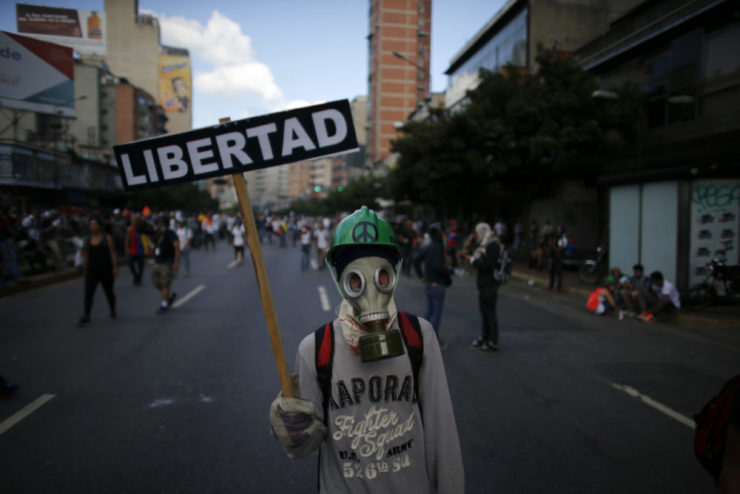
A masked protester holds a sign that reads "Liberty" in Spanish during clashes with government security forces in Caracas in May. Censorship in Venezuela has increased as the political turmoil continues to escalate
Alayon started Prodavinci, with his own money, as a forum for “journalism of ideas, as a response to the lack of in-depth analysis and fact-based journalism,” he says. The site currently employs around 30 people, and Alayón recently opened investigative and data units. Prodavinci also organizes three or four events a year, during which experts in politics and economics discuss the issues the country faces, with admission fees augmenting advertising income. “We’ve established a relationship with our audience based on creativity, quality, and respect,” says Oscar Marcano, Prodavinci’s associate director. “When you provide quality journalism, presented in a creative manner while rigorously exhausting every source of information and angle of the story, the audience feels respected, and it will back you up in the future.”
Marcano’s optimism isn’t totally shared by César Bátiz, editor in chief of El Pitazo, which provides news to low-income Venezuelans. “Very few media are able to survive on advertising income,” he notes. Still, in just two years, El Pitazo has managed to build a national network of journalists with a presence in 22 of the country’s 23 states, at a time when traditional media have been reducing coverage outside the main cities.
El Pitazo maintains a small newsroom in Caracas, but its operation mainly consists of a network of 42 reporters who contribute to the site while also writing for other media outlets. The site delivers SMS highlights of its main stories to the phones of more than 2.5 million residents of the cerros, the densely-populated communities of makeshift shacks found in the mountains surrounding Caracas. El Pitazo started as a project of the non-governmental organization IPYS Venezuela, which promotes independent journalism and freedom of expression, and now has agreements with six other Venezuelan NGOs, focused on civil rights and civic participation, to share its video content in communities where El Pitazo wants to make an impact.
Known for its street reporting, El Pitazo did a series in March about senior citizens like Irmo Subero, a blind man in the state of Monagas who tries to earn money by singing and playing a broken guitar, people who are living on the streets after being abandoned by their families and by the government. Even though the government ignores stories like these, Bátiz believes it’s crucial to record what’s currently happening in Venezuela. “We have to think that our journalistic work will not only remain as documentation of this moment, but also that it will serve as an X-ray of the current times that will be studied by historians,” he says.
Despite the obstacles, vital work continues to be done in Venezuela. Investigative outfit Armando.info, which worked with the International Consortium of Investigative Journalists (ICIJ) to develop the Venezuelan stories derived from the Panama Papers, recently broke the story of how construction giant Odebrecht offered bribes to foreign government officials to secure public contracts. Unlike other digital start-ups, Armando.info does not accept advertising. “We are not interested in any advertiser putting conditions on the topics we are working on,” explains co-editor Alfredo Meza. Instead, the site is funded through donations from organizations like the Open Society. Meza is also looking into putting up a paywall and moving to a subscription model.
In addition to the financial challenges, Meza says lack of cooperation from official sources forces journalists to become more resourceful in obtaining statistics and fact-checking data. Since 2015, important economic indicators such as GDP, annual imports, exports, and the inflation rate have not been reported by Venezuelan government officials. As a result, journalists determine annual imports and exports, for example, by checking with the commerce departments of every country with which Venezuela has traded. For figures like the inflation rate, reporters have to crosscheck numbers with different NGOs and international organizations such as the International Monetary Fund.
“We have to think that our journalistic work will not only remain as documentation of this moment, but also that it will serve as an X-ray of the current times that will be studied by historians” —César Bátiz, editor in chief of El Pitazo
Back in 2009, Nelson Bocaranda, one of Venezuela’s most respected journalists, was informed by the radio broadcaster Onda that his political radio show “Runrunes” (“Rumors”) would not continue to air after the government threatened to revoke the radio station’s license if it didn’t silence Bocaranda’s criticism. In response, Bocaranda and his son, Nelson E. Bocaranda, took “Runrunes” online, turning the radio show into a digital platform for breaking news and investigative reporting. The site now has six staffers in its investigative unit, plus two regular collaborators.
Since the beginning of the current demonstrations in April,“Runrunes,” which has 1.8 million Twitter followers, has been documenting every case in which a protester has died, including infographics on the cause of death, the place where the person died, and whether those responsible for the death have been identified. So far,“Runrunes” has compiled cases for 78 deaths, 18 more than the official number recorded by the Attorney General’s Office.
The work of the Bocarandas highlights one of the ironies of this moment in Venezuelan journalism. As the government has cracked down on traditional outlets, it has inadvertently created a supply of experienced journalists to feed into the newly created digital outlets, including people such as Prodavinci photographer Gabriel Méndez, who’s been covering the protests.
“One of the good things that has come out of the growing censorship and self-censorship is that a young journalistic movement has emerged,” he says. “Watching the sum of little sacrifices many citizens do to overcome daily challenges, the support of my family and colleagues makes me keep on going, no matter how exhausted I may be. It makes me be willing to give the little contribution I can give. I think that we, as a society, feed ourselves off everybody’s good work. It is a sort of crowdfunding, but of courage.”


